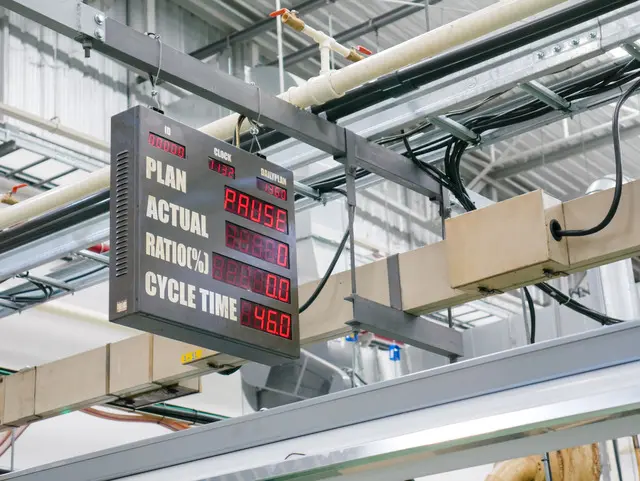Empowering Efficiency: Employee Timesheet Processing Automation
The manufacturing industry is a complex and fast-paced environment where every minute counts. Employee Timesheet Processing Automation is a crucial aspect of payroll management that can significantly impact efficiency and accuracy. Traditional methods of manual data entry and validation are prone to errors, delays, and compliance issues.
Python, AI, and cloud-based solutions offer a transformative approach to Employee Timesheet Processing Automation. By leveraging these technologies, manufacturers can:
- Streamline data entry and validation processes, eliminating manual errors and saving time.
- Automate payroll hour calculations, ensuring accuracy and compliance.
- Enhance visibility and control over employee time tracking, empowering informed decision-making.
Employee Timesheet Processing Automation is not just a technological advancement; it’s a strategic investment in workforce optimization and productivity. By embracing automation, manufacturing companies can unlock the potential for improved efficiency, reduced costs, and a more engaged workforce.

Unveiling the Power of Python, AI, and Cloud for Employee Timesheet Processing Automation
Python is a versatile programming language that has emerged as the go-to choice for developing Employee Timesheet Processing Automation solutions. Its simplicity, extensive libraries, and open-source nature make it ideal for building both unattended and attended bots.
Unattended bots, powered by Python, can seamlessly automate repetitive and time-consuming tasks such as data entry, validation, and payroll hour calculations. These bots operate in the background, eliminating the need for human intervention and ensuring uninterrupted processing.
Attended bots, also built with Python, provide a more interactive experience by assisting employees with their timesheet-related tasks. They can guide employees through the process, answer queries, and even flag potential errors, enhancing accuracy and efficiency. The level of customization available when building attended bots with Python allows manufacturers to tailor the automation to their specific requirements.
Cloud platforms offer a comprehensive suite of features and capabilities that far surpass traditional RPA/workflow tools orchestrators. By leveraging the cloud, manufacturers can:
- Access a vast ecosystem of pre-built connectors and services, simplifying integration with existing systems.
- Scale automation solutions effortlessly to accommodate growing business needs.
- Benefit from enterprise-grade security and compliance measures, ensuring data integrity and privacy.
AI plays a pivotal role in enhancing the accuracy and efficiency of Employee Timesheet Processing Automation. Techniques such as image recognition can automate the extraction of data from scanned timesheets, eliminating manual errors. Natural language processing (NLP) can interpret handwritten notes or employee queries, providing more context for automated decision-making. Generative AI can even generate timesheet templates or provide insights into workforce patterns, empowering data-driven decision-making.
By harnessing the combined power of Python, AI, and cloud platforms, manufacturers can unlock the full potential of Employee Timesheet Processing Automation, driving efficiency, accuracy, and productivity to new heights.

Building the Employee Timesheet Processing Automation with Python and Cloud
The Employee Timesheet Processing Automation process can be broken down into several key sub-processes:
- Data Extraction: Extracting timesheet data from various sources, such as scanned documents, emails, or spreadsheets.
- Data Validation: Verifying the extracted data for accuracy and completeness, flagging any errors or inconsistencies.
- Payroll Hour Calculation: Calculating payroll hours based on the validated timesheet data, taking into account factors such as overtime, breaks, and leave.
Using Python and cloud platforms, each of these sub-processes can be automated as follows:
Data Extraction:
– Utilize Python’s image processing libraries to extract data from scanned timesheets.
– Integrate with cloud-based OCR services for accurate text recognition.
Data Validation:
– Define validation rules in Python code, checking for missing data, incorrect formats, and outliers.
– Leverage cloud-based data validation tools to enhance accuracy and consistency.
Payroll Hour Calculation:
– Develop Python scripts to perform complex payroll calculations, considering various factors.
– Integrate with cloud-based payroll processing services for automated payroll generation.
Data Security and Compliance:
– Implement encryption and access controls in Python code to protect sensitive employee data.
– Comply with industry-specific regulations and standards, such as ISO 27001 and GDPR.
Advantages of Python over No-Code RPA/Workflow Tools:
- Flexibility and Customization: Python provides unparalleled flexibility to tailor the automation to specific business requirements.
- Scalability and Performance: Python scripts can be easily scaled to handle large volumes of timesheets, ensuring optimal performance.
- Integration with Cloud Platforms: Python seamlessly integrates with cloud platforms, leveraging their powerful features and scalability.
Algorythum’s Approach:
Algorythum takes a Python-based approach to Employee Timesheet Processing Automation due to the limitations of off-the-shelf RPA/workflow tools. These tools often lack the flexibility, scalability, and performance required for complex manufacturing environments. By leveraging Python and cloud platforms, Algorythum delivers tailored solutions that meet the unique needs of each client, ensuring maximum efficiency, accuracy, and compliance.

The Future of Employee Timesheet Processing Automation with Algorythum
The future of Employee Timesheet Processing Automation is bright, with exciting possibilities to extend the implementation and enhance the solution using emerging technologies. Here’s a glimpse into what the future holds:
-
Cognitive Automation: Integration with cognitive technologies, such as natural language processing (NLP) and machine learning (ML), can enable the automation to understand and respond to complex employee queries, providing a more intuitive and personalized experience.
-
Real-Time Processing: Leveraging real-time data streaming technologies can enable the automation to process timesheets as they are submitted, eliminating delays and providing up-to-date insights into workforce patterns.
-
Mobile Integration: Mobile applications can be integrated with the automation, allowing employees to submit timesheets and access relevant information on the go, enhancing flexibility and convenience.
-
Predictive Analytics: Advanced analytics techniques can be employed to identify trends and patterns in timesheet data, providing valuable insights for workforce planning and optimization.
By subscribing to Algorythum’s newsletter, you’ll stay informed about the latest advancements in Employee Timesheet Processing Automation and other industry-specific automation solutions.
Contact our team today for a free feasibility and cost-estimate for your custom requirements. Let us help you unlock the full potential of automation and transform your Employee Timesheet Processing operations for greater efficiency, accuracy, and compliance.

Algorythum – Your Partner in Automations and Beyond
At Algorythum, we specialize in crafting custom RPA solutions with Python, specifically tailored to your industry. We break free from the limitations of off-the-shelf tools, offering:
- A team of Automation & DevSecOps Experts: Deeply experienced in building scalable and efficient automation solutions for various businesses in all industries.
- Reduced Automation Maintenance Costs: Our code is clear, maintainable, and minimizes future upkeep expenses (up to 90% reduction compared to platforms).
- Future-Proof Solutions: You own the code, ensuring flexibility and adaptability as your processes and regulations evolve.









